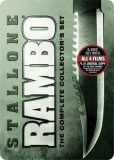| Reviews & Columns |
|
Reviews DVD TV on DVD Blu-ray 4K UHD International DVDs In Theaters Reviews by Studio Video Games Features Collector Series DVDs Easter Egg Database Interviews DVD Talk Radio Feature Articles Columns Anime Talk DVD Savant Horror DVDs The M.O.D. Squad Art House HD Talk Silent DVD
|
DVD Talk Forum |
|
|
| Resources |
|
DVD Price Search Customer Service #'s RCE Info Links |
|
Columns
|
|
|
Rambo - The Complete Collector's Set
THE MOVIES:
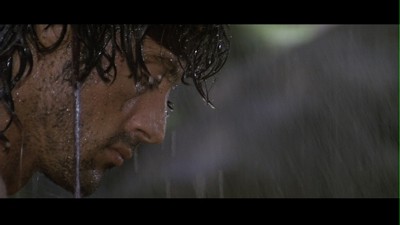
John Rambo, as played by Sylvester Stallone, is one of those iconic characters of the 1980s that I grew up with. It's actually kind of funny, with all of this Indiana Jones mania going on at the moment, to think that the two franchises followed very similar release paths, with each of the four entries in both series coming out within a year of each other. I'm not sure what one character would think of the other if ever they were to crossover, but we could probably make a guess based on the fact that one carried a knife as his trademark weapon and the other a whip. Indiana Jones was all about nostalgia, about a time when adventure was clean and the good and the right were truly good and right; the mythology of John Rambo was far more complicated than that.
I spent a lot of time watching action movies with my father, so I saw both First Blood (1982) and its sequel, Rambo/First Blood Part II (1985), in the theatre with the old man. I remember First Blood having a profound effect on me. It's plot of a lone wolf character drifting through life and reacting harshly to correct wrongs done against him was an action movie trope I would soon come to love. In his way, Rambo was like a masterless ronin in a Japanese samurai picture or Clint Eastwood's Man With No Name. He says very little, but thinks very deeply, and let's his actions communicate with the world for him. Of course, I didn't realize back then, at the ripe old age of ten, that the movie came loaded with a far more complicated morality and political backbone than your typical spaghetti western. The dialogue of how America was talking about the Vietnam War and dealing with its aftermath was starting to change, and the trajectory of the early John Rambo stories (including the novel by David Morrell, upon which First Blood was based) keeps the character at the forefront of the debate.
Not that the films ever get bogged down in those politics. Sometimes, arguably, they are tainted by the heavy hand of pseudo-propaganda, but eventually the final two sequels, Rambo III from 1988 and last year's Rambo, moved on from Vietnam and into other war zones--and even the second movie is more about big, dumb action than it is about making you think. Despite the message in all of them, the intent was always to give the audience lots of violent excitement. Moviegoers wanted Sylvester Stallone running around with no shirt on shooting at people, and that's exactly what they got.
To commemorate the first release of the 2008 movie on DVD, Lionsgate hasn't exactly done a complete overhaul of the Rambo series, but they have taken the 2004 "Ultimate Editions" of all three original movies and put them together with the "Special Edition" of the latest installment, dropped them into a tin, and called it Rambo - The Complete Collector's Set. I don't own any of the previous releases (the trilogy set first came out in 2002 from Artisan, and this is actually my first time seeing the third and fourth movies), but from what I can tell there hasn't been any real upgrade in picture or sound for these new editions (though there might have been some tweaking in order to prep them for Blu-Ray; see our reviews elsewhere on the site), but those who are interested will be happy to hear that the bonus features from the original 2002 release that were dropped from the 2004 discs are now restored as a disc of supplemental documentaries. There are six discs in all in the collection: one for each movie, the documentary disc, and a DVD devoted solely to a digital copy of Rambo that you can download to your PC or iPod.
Thus, even though the 2004 box was called the Ultimate Collection, this one almost lives up to its name, the Complete Collector's Set. Everything is under one lid at last--minus one notable extra, the audio commentary by David Morrell on First Blood that was originally on the 2002 disc. The packaging for the Complete Collector's Set says that it should be on the lead DVD--and it has surfaced again on the Blu-Ray edition--but it is not actually on the First Blood DVD included here. I searched the menus, switched the audio around, did everything I could, but it appears that it was not added back onto the new version.
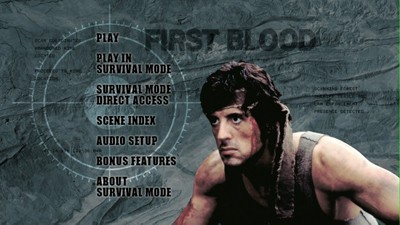
First Blood, of course, is the film that started it all, and it's hands down the best of the franchise. Former Green Beret John Rambo (Stallone) wanders into an Oregon town and is instantly spied by its judgmental Sheriff (Brian Dennehy). Deciding that the long-haired wanderer is nothing but a troublemaker, Sheriff Teasle tries to hurry him on his way to Portland, but Rambo doesn't like to be muscled. When he is arrested for vagrancy, a sadistic cop (Jack Starrett) pushes his buttons, triggering brief flashbacks to Rambo's time as a POW. Enraged, the super soldier goes into attack mode. He escapes from jail, heads into the mountains, and holds off various arms of the police and the National Guard before taking his private war back into town and being talked down by his former Colonel, Sam Trautman (Richard Crenna).
Clocking in at an extremely efficient ninety-four-minutes, First Blood still impresses for how effortlessly it lays its background story, giving the most room to the stunts and the fights. Far from being a perfect machine, even though the character remains pretty much untouchable, Rambo does get kicked around quite a bit. If he takes a tumble, it's a real tumble, and he is capable of being hurt. Most of the sequences, minus a few easy exploding cars, are believable and pulled tight with real tension. The filmmakers--screenwriters Michael Kozoll and William Sackheim and director Ted Kotcheff--deserve a lot of credit for going for a more complicated conclusion than just having Rambo blow everything up and walk away as the righteous man. In fact, I'd say the film even avoids making him righteous. Though the final confrontation between Stallone and Crenna dredges up a lot about the history and the pain of the men who fought in Vietnam, Rambo is not exonerated for his reaction to being brutalized. In keeping with the nature of the problem--a problem that created a troubled man like John Rambo--the filmmakers choose to keep their portrayal of the anti-hero complicated, as well.
So, in terms of genuine story and the violent action--arguably, First Blood is like one long chase picture, with the role of hunter and hunted constantly flipping--this first Rambo movie holds together extremely well. It shows Stallone at the top of his game, giving equal weight to both the brains and the body, so that the narrative and the visceral elements of First Blood work in tandem.
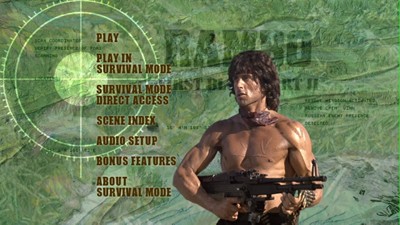
This, of course, did not last. The reflexive response to success in Hollywood is always to go bigger the next time around. Spend more money, make more money. Rambo/First Blood Part II, written by Sylvester Stallone and James Cameron, is a different animal from the get-go. The production values are higher, and so is the level of self-awareness. From the first big reveal of Stallone through to the climactic bloodbath and the grandstanding ending, this second blood flows much heavier than the first.
Part of a burgeoning genre of POW rescue pictures that included Kotcheff's Uncommon Valor and the Chuck Norris Missing in Action series, First Blood Part II sees Trautman sending Rambo back to the Vietnamese prison camp he escaped from fourteen years earlier to collect intelligence on whether or not Americans are still being held there. Backed up by a group of mercenaries, Rambo is double-crossed, if for no other reason to prove that America still does not care enough, and ends up back in prison, fighting the double-bogie of the Vietcong and their Russian friends. With the help of a female sidekick (Julia Nickson-Soul), Rambo escapes and once again picks up the knife in the cause of justice.
First Blood proved the Rambo character was at his best when no one was talking. A stoic figure, he barely says a word in that film. In First Blood Part II, everyone needs to shut up, because just about anytime someone talks, their line is either a slogan or a punchline, emphasis on pun. When Trautman springs Rambo from the pen at the start of the movie, Stallone forgets to take subtlety back outside the prison gates with him. Director George P. Cosmatos (who had yet to commit his worst cinematic crime, his Stallone reteaming Cobra) thankfully makes up for what he lacks in narrative finesse with a solid grasp of what it takes to make good action. Setting the jingoism and plot contrivances aside, Rambo/First Blood Part II is still an enjoyable film to watch, because stuff blows up real good and the film's hero, no longer morally questionable, leaves a huge body count all across the jungle floor. It's not a movie you'll always be proud of liking, but go ahead and enjoy yourself anyway.
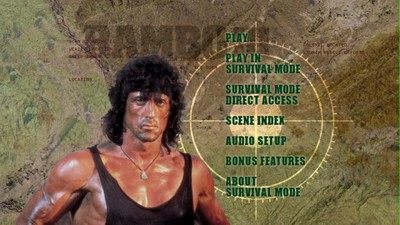
Besides, you've still got Rambo III to sit through, and here's where the bottom of that barrel comes rushing up fast. You can almost judge how bad the Rambo movie will be by the size of Stallone's hair. In III, that lion's mane is epic!
Since his liberation of the POWs in the previous film, John Rambo has lived in Thailand, engaging in brutal fights for money he then turns around and gives to the Buddhist temple that provides him sanctuary. Having found peace, he refuses Trautman when the Colonel asks his protégé to travel with him to Afghanistan to aid the people in fending off the Russian invaders. When Trautman ends up captured by the Commies, Rambo is the only person who can get him out. He goes to Afghanistan, learns a little about the war, and single-handedly takes on the Soviet army.
Calling Rambo III over-the-top is a little like calling the ocean a puddle. More violence, more explosions, and even more self-justification via political mumbo jumbo (Charlie Wilson must have loved this flick). After Stallone's unintentionally hilarious speech at the tail end of First Blood Part II, I guess his squinty-eyed compassion and acceptance of his role as the savior of the world's bullied should be no surprise, but the manipulative tactics of Stallone and his co-writer Sheldon Lettich and director Peter MacDonald are a bit much. Stallone watches and listens with a grave expression as the plight of the Afghan people is explained to him, joins in their games, and then chokes back the tears as we literally see mothers gunned down as they flee with their children. Accurate or no, I can tell when my conscience is being used as a heavy bag. Which would be acceptable if the battle sequences weren't so overblown and repetitious. The entire film has a feeling of been-there-done-that, from the story structure (Rambo goes in, fails the first time, has to go back) to the face-off between superhuman archer and Russian helicopter. It's just that this time everything is cranked up to 11. If Rambo downed a can of Coke in the previous film, he's going to drink a 2-liter bottle in Rambo III!
I can't say the movie is boring, but it's also not so outrageous that it could fall into a "so bad it's good" category. Maybe they should have called it First Blood Part III: John Rambo's Poodle-Haired Folly.
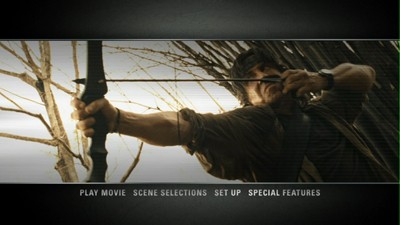
The singly named Rambo was this year's return of the franchise. Flush from his critical and moderate box office success resurrecting his other famous character in Rocky Balboa, Stallone decided to give John Rambo a fourth go-around. Pumped up so large now that he looks like some kind of mythical beast, the 62-year-old actor/writer/director isn't as spry as he once was. At the same time, his moviemaking is no longer so easygoing or so flippant.
This latest installment finds Rambo twenty years later. He has returned to Thailand and now makes his living capturing snakes for tourist side shows. In probably the most realistic character development since First Blood, he has rejected the outside world and now lives a solitary life of toil. He doesn't believe the world will ever have the guts to change, to make the tough choices and do what needs to be done. Hence, he at first refuses the missionaries who come to him seeking ferry to the genocidal war zone of Burma. Medicine and Bibles can't solve a problem that only force can tamp down. Only when the pretty, kind woman of the group, Sarah (Julie Benz), appeals to his existential angst does Rambo give in and offer to take them up the river.
It's hard to miss Stallone's general point here: the sensitive liberals need to be shown that band-aids can only accomplish so much in the face of oppression. The missionaries aren't in Burma a full day before the warlords attack the village they are visiting, burning it to the ground and taking Sarah prisoner. This casts Rambo as the rescuer yet again.
And yet, Rambo has a sobriety that the middle pictures in the series lacked. Rambo takes no relish in his mission and does even less to explain himself than he has in the past. He is a world-weary figure now, tired of explaining the way of things to an indifferent civilian populace. If the point is that only action will matter, than Stallone will deliver the action. This time around, though, it won't be prettied up. There is no ostentation; rather, it's dirty and vile, and the actor/director is going to show you how much so. Heads explode, limbs are wrenched from bodies, blood and guts are everywhere. It's not the 1980s anymore, a movie hero can't play at war, he's got to be down in the muck of it.
Some will argue that Stallone has only upped the "realism" as an excuse to be more gory and thus more bankable, and it's not an argument I can or would completely knock down. The entire Rambo series has tried to justify its actions even as it ratchets up the exploitation factor from film to film. Cynicism is definitely allowed here. The sheer body count of Rambo is astounding. Even so, if you compare it to the also sobering reality of Rocky Balboa, I'd say we're seeing a new, older Stallone who feels the consequences of life in ways a younger man never can. His own body has probably taken some of the punishment that Rocky's would have taken in the ring, and I am sure in the world we live in today, it would be tough to remain as rah-rah about might making right as he once was. I think he wants us to see all the gross details because he really believes we need to understand what it is we're cheering for. If the idea was always to acknowledge the sacrifice that soldiers make in war, then this is a portrait of the permanent scars a life of sacrifice would leave. John Rambo is a man plagued with nightmares, haunted by his past, and unable to break the cycle of violence.
Which isn't to suggest that Rambo is deep and soulful, because it's actually simplistic, often repugnant, and won't leave you feeling very good about the human race. It's just that it's not the empty slogan the franchise had become, and thus a more fitting end chapter for the character, returning him closer to the guy we met back in First Blood. It's also a supremely effective action movie, moving at a breathless pace that should keep you hanging on the edge of your seat right up until the monstrously violent end. The movie itself is one big exit wound (the hole in the DVD should have blood all around it), and not to be recommended to the weak of heart, but it does bring some redemption to a hero who took a wrong turn somewhere around 1988.
Plus, his hair? Not great, but much better.
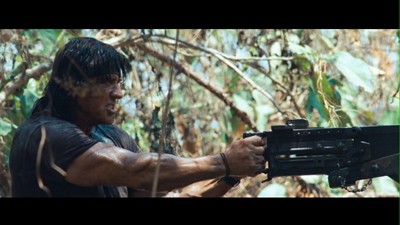
THE DVD
Video/Sound:
All four Rambo movies were shot at a 2.35:1 aspect ratio, and these discs all preserve the original image in a nice anamorphic transfer. Naturally, the older films show their age a little bit, but mainly in terms of different standards of the times, with First Blood having a slight early '80s grain. In general, the Rambo films have always been treated well in the digital age, and so colors and resolution are all of a fine quality. I noticed a rather hard layer shift in First Blood when it switched from chapter 17 to 18, but it's really the only glitch of that kind I could call out. The newest film, Rambo, is the only unknown quantity here, and it easily looks even better than its younger siblings. Stallone shot this film darker and grittier, utilizing faster shutter speeds and more modern equipment, and every grimy detail comes through on the pristine DVD transfer.
The "Ultimate Editions" of 1-3 all have two English audio mixes: 5.1 and 2.0. These are decent mixes, making the most of older soundtracks, pushing them hard to work with surround technology. All three of the original films also feature an optional English closed captioning function.
Rambo has a razor sharp Dolby 5.1 mix, and just as with the picture, working with the technology available now that wouldn't have been available to him twenty years ago, Stallone fills the speakers with effects. This particular DVD also has the choice of English or Spanish subtitles.
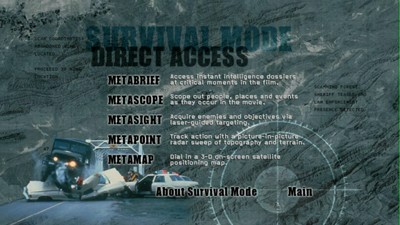
Bonus Features:
One highlight of the Ultimate Editions of the original trilogy was the "Interactive Military Special Operations Features." These are essentially military-related files that explain different aspects of the production through text, videos, and photographs. Some of these are files for your computer, others are part of the "Survival Mode"--essentially, as you watch the movie, if "Survival Mode" is on, an icon appears on the screen and you have the option of selecting it with your remote. If you do, it takes you to the bonus files. This can be hit or miss and also get redundant from one sequel to the next, so thankfully, you can also choose any of these pieces through a separate menu that will let you browse exactly what you want to know without interrupting your viewing.
Disc 1: First Blood has as its main extra a fairly substantial, engaging commentary from Sylvester Stallone. Stallone talks in detail about the production, about how the movie was made and different permutations it nearly took. Unfortunately, as noted above, the advertised commentary from the writer of the original novel, David Morrell, that was on the earliest DVD release of the film is not on this new edition, it's only been restored for the Blu-Ray.
Three deleted scenes are also included: two are variations of the infamous "suicide ending," a straight take of it and one that ends with a joke. The third scene shows Rambo flashing back to a barroom romance in Saigon, and despite the presence of boobies and Stallone's pornstar moustache--or perhaps because of these things--appears to be a smart trim in terms of the storytelling in the picture.
Disc 2: Rambo/First Blood Part II has another audio commentary, this time with director George P. Cosmatos. It's a solid nuts-and-bolts accounting of the production. About average as these things go.
Disc 3: Rambo III also has a fairly average director's commentary, with Peter MacDonald talking about the large-scale production, including the difficulties of location shooting and recreating Afghanistan in the Arizona desert. (Likewise, much of Part II was shot in Mexico.) Rambo III gets slightly more by way of extras than the first two, with eight deleted scenes, including another alternate ending alongside another joke version of that same alternate ending, just like on First Blood. We also see more mayhem, more torture/interrogation, and a scene of an Afghani wedding.
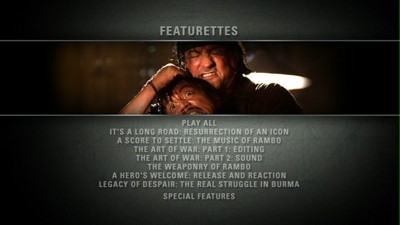
Disc 4: Rambo - A new film means all new extras, and there is a bounty. First-up, like all the others, is an audio commentary, once again with Stallone. As with the First Blood commentary, this one is very detailed and really digs into everything that goes into making a movie. Despite his reputation for characters who don't speak such good English, Stallone is actually an eloquent speaker and an excellent storyteller (who else would use the phrase "lethal finesse"?). Expect no stone to be left unturned on this track, from discussing why Burma as a subject to specific details about the production and the story.
This Special Edition DVD has seven new featurette documentaries:
* "It's a Long Road: Resurrection of an Icon": Your standard making-of, running just under twenty minutes, starting with the struggle to find the idea that would be right for the fourth film, including the various discarded concepts. On-set footage in Thailand, illustrates discussions of the production, featuring interviews with the crew and cast. One interesting aspect is the use of actual Karen rebels from Burma as actors, including the man who plays the oppressive warlord. Also, Stallone's method approach to directing. (Hint: Rambo directed his own movie.)
* "A Score to Settle: The Music of Rambo": Close to seven minutes on Brian Tyler's approach to the music for Rambo and following in the footsteps of Jerry Goldsmith.
* "The Art of War: Completing Rambo - Part I, Editing": Another near seven minutes, this time with Stallone and editors Sean Alexander and Paul Harb, who had previously worked with Stallone on Rocky Balboa, discussing working on the movie under a tight deadline and the amount of footage to cull from since the movie was shot with multiple cameras, and the challenge of working on a hard R-rated picture.
* "The Art of War: Completing Rambo - Part II, Sound": Just over three minutes discussing sound effects and mixing.
* "The Weaponry of Rambo": A smidgen over fourteen minutes discussing the technical side of arming the characters in Rambo, led by Kent Johnson, the property master on the picture. Each gun is matched to its character, and the reasons for choosing it are explained. Some of the training in weapons use and filming is shown, and the actors discuss their experience.
* "A Heroes Weclome: Release and Reaction": Nine-and-a-half minutes of the production patting itself on the back, with footage from the Vegas premiere. Also, the reaction to the violence and responses from members of the military, as well as the movie's reputation in Burma/Myanmar.
* "Legacy of Despair: The Struggle in Burma": Close to eleven minutes about what is actually going on in Burma and its relation to the film, featuring human rights activists.This includes some harrowing documentary footage of atrocities going on in the civil war over there.
Four deleted scenes mainly give us more time between Sylvester Stallone and Julie Benz. Two longer scenes in Thailand of her trying to convince him to take the missionaries up the river really belabor the point, as does their extra conversation once they are on the boat. The final scene is on their flight out of Burma, when the two must pause so Rambo can clean and dress the wounds on her feet, and it might not have been a bad breather to keep in the manic flight for freedom.
Lastly, we get the trailers for Rambo, the 20th anniversary edition of Hamburger Hill, and this boxed set. The latter two also play when the DVD loads.
Disc 5: Rambo - Digital Version: This would comprise disc 2 of those buying the Rambo: Special Edition all on its own, and it seems like a rather unappealing lure to get me to buy the 2-disc edition rather than the cheaper 1-disc. For about $5 extra retail, you get this extra DVD which is set up for loading a digital version of the fourth Rambo onto your home computer or iPod. I guess this may seem like added value for some, but not for me.

Disc 6: Bonus Disc, on which almost all of the old features from the 2002 releases and the bonus disc from the Rambo Trilogy: Special Edition released by Artisan are gathered. From what I can tell, only a couple of short musical montages have been dropped, and from what I've read, they are inconsequential anyway. Beyond them, we get ten documentaries of varying lengths, some as short as a few minutes, others as long as thirty, and all four trailers for the movies in the set.
Those documentaries from the old bonus disc are:
* "The Real Nam: Voices from Within" - a half-an-hour documentary that examines the realities of Vietnam, including the complicated politics and the harsh battle conditions.
* "Guts and Glory" - twenty-seven minutes on the Rambo phenomenon and how the character came to personify Reagan's '80s. This includes opinions from Sylvester Stallone and Ted Kotcheff alongside scholars and historians.
* "The Forging of Heroes: America's Green Berets" - Another historical piece, ten minutes on the origins of these special operatives, their training, and their legacy.
* "Rambo-nomics" - a short three minutes about this money-making juggernaut.
* "Selling a Hero" - Just under five minutes about the toys marketed under the Rambo name.
* "Suiting Up" - A featurette (eight minutes) studying the weapons in the movies.
* "An American Hero's Journey: The Rambo Trilogy" - A vintage twenty-five minute documentary about the series, featuring an overview of the franchise, interviewing participants alongside clips of the films. (From here, some of the information starts to get a little redundant.)
The documentaries for the individual movies:
* "Drawing First Blood" - An informative making-of that features what were new interviews at the time of its making six years ago. Included in the mix are Stallone, Kotcheff, writer David Morrell, the late Richard Crenna, and executive producers Mario Kassar and Andrew Vajna. Just over twenty-two minutes, this runs us from start to finish, from the book to the final cut of the movie.
* "We Get to Win This Time" - The making-of for the second movie, about twenty minutes. In addition to the above participants, the film's editors join the fray alongside director George P. Cosmatos and actors Charles Napier and Julia Nickson-Soul. Given the fact that a new franchise was riding on the back of this picture, it went through a lot of development, various aspects of which are revealed.
* "Afghanistan: Land in Crisis" - Nearly half-an-hour, this is less about the movie and more about the history behind the movie, once again bringing in scholars and historians, as well as Stallone, to talk about the real-life war as well as to contextualize Rambo III for a post-9/11 world. All six DVDs are housed inside a folding cardboard book, each getting their own plastic tray. The book is then held inside an embossed tin box. Various paper inserts are loose in the package, including a rundown of the special features on each DVD, an explanation of how to access the digital copy of Rambo, and a detachable cardboard back cover that is inside the packaging's shrinkwrap for purposes of displaying it on store shelves.
FINAL THOUGHTS:
Sylvester Stallone's Rambo franchise is by no means a perfect series. Of the four films, only one is a picture I'd say distinguishes itself as something more than an excuse to set off a lot of explosives and bloody squibs. Still, out of the bullet-riddled quartet in Rambo - The Complete Collector's Set, three are solid entertainment and the fourth (Rambo III) manages to at least keep from sinking completely under its own stupidity. As a package, this set can't be beat as far as fans of the films are concerned. It's the only place to get all four excursions into enemy territory, and it gives us nearly every extra that has cropped up on the various DVD releases over the past six years. Recommended.
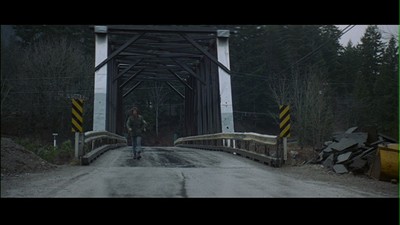
Jamie S. Rich is a novelist and comic book writer. He is best known for his collaborations with Joelle Jones, including the hardboiled crime comic book You Have Killed Me, the challenging romance 12 Reasons Why I Love Her, and the 2007 prose novel Have You Seen the Horizon Lately?, for which Jones did the cover. All three were published by Oni Press. His most recent projects include the futuristic romance A Boy and a Girl with Natalie Nourigat; Archer Coe and the Thousand Natural Shocks, a loopy crime tale drawn by Dan Christensen; and the horror miniseries Madame Frankenstein, a collaboration with Megan Levens. Follow Rich's blog at Confessions123.com.
|
| Popular Reviews |
| Sponsored Links |
|
|
| Sponsored Links |
|
|
| Release List | Reviews | Shop | Newsletter | Forum | DVD Giveaways | Blu-Ray | Advertise |
|
Copyright 2024 DVDTalk.com All Rights Reserved. Legal Info, Privacy Policy, Terms of Use,
Manage Preferences,
Your Privacy Choices | |||||||









